List of Contents
What is Low Fat Cheese Market Size?
The global low fat cheese market size is calculated at USD 115.05 billion in 2025 and is predicted to reach around USD 157.08 billion by 2034, expanding at a CAGR of 3.52% from 2025 to 2034. The low fat cheese market growth is attributed to increasing consumer health consciousness and the expansion of innovative product offerings that cater to dietary preferences.
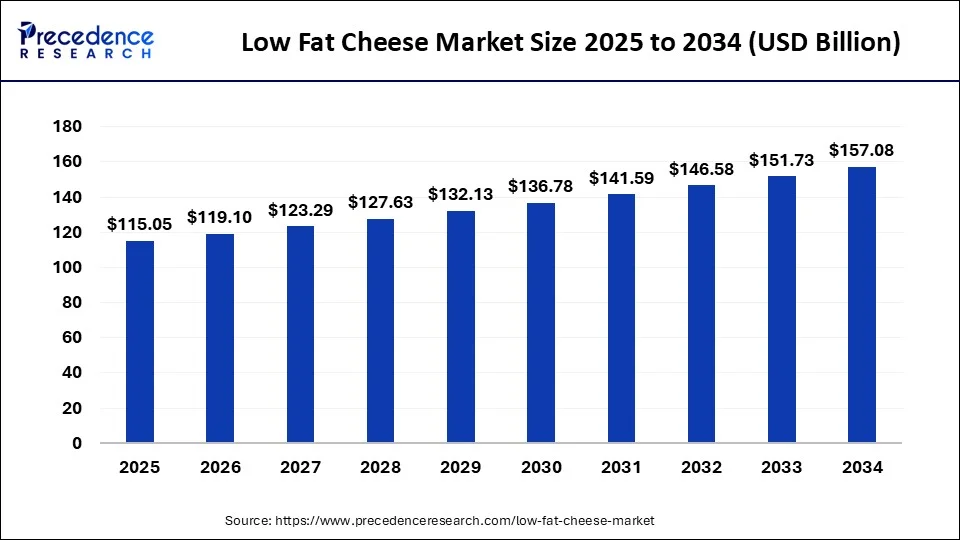
Market Highlights
- Europe dominated the global low fat cheese market with the largest market share of 35% in 2024.
- Asia Pacific is projected to host the fastest-growing market in the coming years.
- By product, the ricotta segment generated the biggest market share of 35% in 2024.
- By product, the mozzarella sticks segment is expected to grow at the fastest CAGR of 3.72% during the forecast period.
- By distribution channel, the retail segment accounted for a biggest market share of 54% in 2024.
- By distribution channel, the food services segment is anticipated to grow with the highest CAGR in the market during the studied years.
What is Low Fat Cheese?
Consumer's global awareness of their health has a multiplier effect on the low fat cheese market. People are cautious about their fat intake and its effects on the human body, including obesity and cardiovascular diseases. Technological developments in the creative process for the formulation of foods have made it possible to produce low fat cheese that is acceptable in terms of taste and texture.
The Food and Agriculture Organization (FAO) notes that packaging has been enhanced by new innovative solutions that have led to shelf-life adjustment and enhanced distribution, thereby increasing the accessibility of these products. The low fat cheese market growth trajectory reflects the growing societal sensibility for bettering their health and the nutritional value of the products they consume, and it shows that low-fat cheese is an acceptable choice for fat-conscious individuals.
- In a CDC report, it was estimated that 40.3% of the grown population in America was considered obese in the years 2021 to 2023, making people look for food with few calories.
What is the Impact of Artificial Intelligence on Low Fat Cheese Market?
Artificial intelligence is being integrated into sectors of the food industry by increasing and enhancing productivity in production quality control and supply chains. AI in the low fat cheese market allows the identification of changes in factors, such as temperature, humidity, and bacterial culture growth, that affect the quality of the final product to be improved. Data analytics powered by artificial intelligence allow companies to better anticipate demand and thereby smoothly avoid problems with overstock or stockout. Additionally, AI helps to develop recipes that do not affect the taste and texture profile of products, further creating demand for low-fat cheese products.
What are the Growth Factors in the Low-Fat Cheese Market?
- Rising demand for plant-based, low-fat cheese alternatives is expected to drive market expansion due to increasing vegan and lactose-intolerant populations.
- Surging online retail platforms across emerging economies are projected to boost the accessibility and availability of low-fat cheese products.
- Increasing adoption of low-fat dairy products in the food service industry, especially in restaurants and fast food chains, is anticipated to fuel market demand.
- Growing awareness about the benefits of low-fat diets is likely to spur demand for low-fat cheese, especially among health-conscious consumers.
- Government campaigns promoting healthy eating and dietary regulations, particularly in Europe and North America, are expected to support the low fat cheese market growth.
- The rising prevalence of obesity and cardiovascular diseases in urban areas is estimated to increase the preference for healthier cheese options.
- Technological advancements in cheese production to improve the taste and texture of low-fat cheese products are projected to attract a broader consumer base.
Low Fat Cheese Market Outlook
- Industry Growth Overview: There will be significant growth in the low-fat cheese market between 2025 and 2030 as consumers try to eat healthier. Consumers' need for more protein-rich, lower-calorie foods has been a major factor in North America and Europe, adopting low-fat cheese products rapidly.
- Global Expansion: There is a growing trend of major dairy producers moving into international markets, such as the Asia Pacific, LATAM, and the Middle East, as a way to target the increased awareness of health-related issues associated with dairy consumption. Expansion into these markets is being facilitated by new production facilities being built and new partnerships with retail stores, thereby allowing dairy producers to have a larger share of the market in these emerging economies.
- Key Investors: Major investors are entering the dairy industry because of stable operating margins, an increased number of health-conscious consumers, and increased penetration into retail channels. Due to their innovation in the fields of low-fat, fortified dairy products, companies that are receiving venture capital (VC) investment are attracting investors.
- Startup Ecosystem: Within the start-up ecosystem, companies focusing on plant-based low-fat cheese, advanced fermentation methods, and allergen-free formulations are becoming more and more popular. Many start-ups are attracting substantial amounts of VC investment through the use of cutting-edge technology and innovative clean-label products.
Market Scope
| Report Coverage | Details |
| Market Size in 2025 | USD 115.05 Billion |
| Market Size in 2026 | USD 119.10 Billion |
| Market Size by 2034 | USD 157.08 Billion |
| Market Growth Rate from 2025 to 2034 | CAGR of 3.52% |
| Largest Market | Europe |
| Base Year | 2024 |
| Forecast Period | 2025 to 2034 |
| Segments Covered | Product, Distribution Channel, and Regions |
| Regions Covered | North America, Europe, Asia-Pacific, Latin America and Middle East, & Africa |
Market Dynamics
Drivers
Increasing health awareness among consumers
Rising health consciousness among consumers is projected to drive demand for the low fat cheese market. Health consciousness among consumers regarding obesity and cardiovascular diseases, including diabetes, has greatly pushed their demand for low-fat cheese products. International health organizations, including WHO, identified spinal obesity and diabetes cases on the rise in 2023. These health risks increase, especially in North America, Europe, and the Middle East; manufacturers are widening their low-fat products for which millennial and GenZ consumers are paying a premium, given their focus on wellness. Furthermore, many brands continue to create products based on the growing knowledge of health consequences further.
- The estimated global prevalence of diabetes was over 529 million in 2021 and is forecasted to rise to an astounding 1.3 billion people by 2050, as per the Institution of Health Metrics and Evaluation.
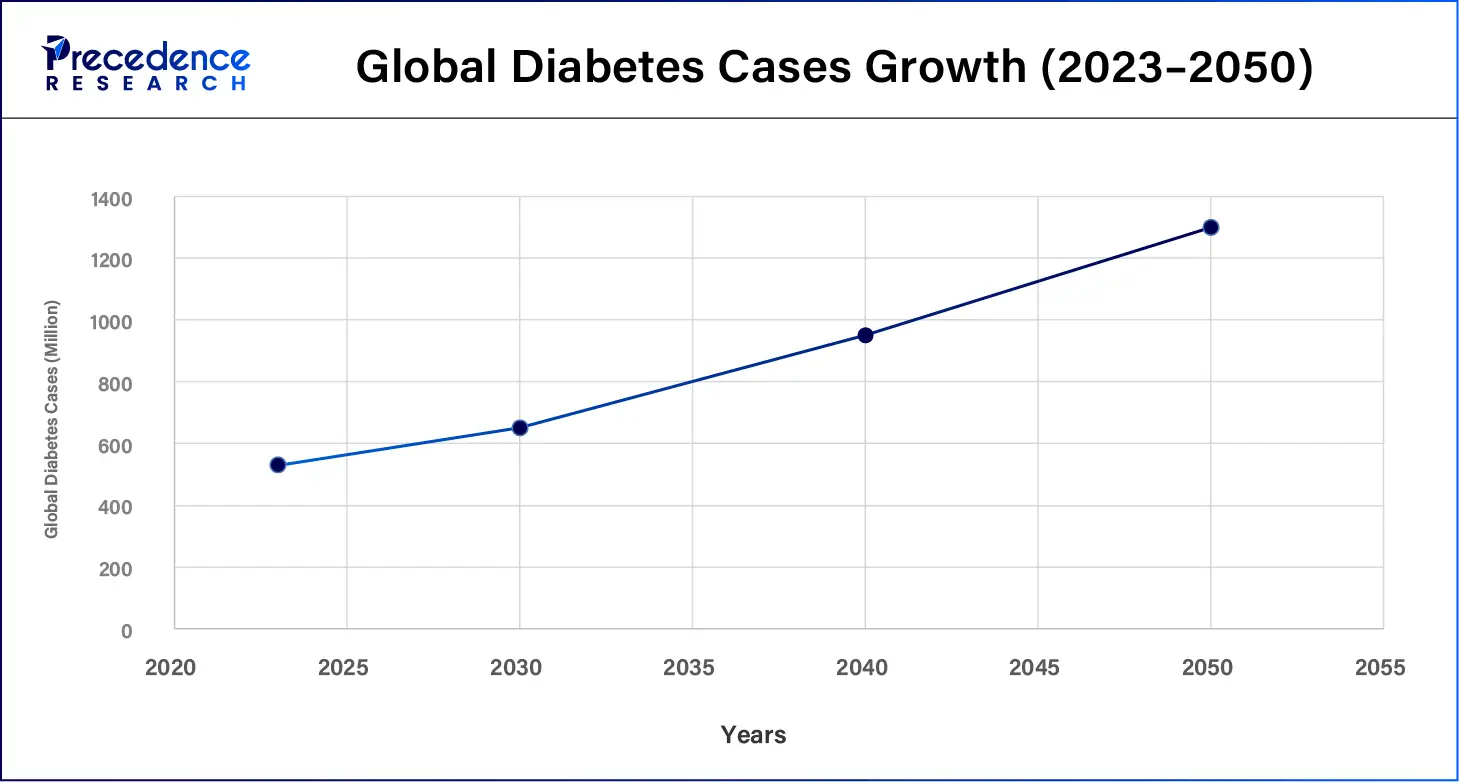
Restraint
High production costs
High production costs associated with low-fat cheese are expected to restrain the low fat cheese market growth. Low-fat cheese involves a special sort of processing where fat has to be either separated or minimized in the production of cheese. Such processes require costly inputs, increased stages in utilization, and the incorporation of modern technologies. This, in turn, makes the low-fat cheese products expensive to produce compared to normal cheese products. Moreover, the price-conscious customers and sort of pricing gap curtails broader market access and penetration.
Opportunity
Increasing innovation in product development
The rising focus on product innovation offers favorable opportunities for the players competing in the low fat cheese market. New ideas and research in food science are allowing companies to come up with new products with improved flavors and mouthfeel while being low-fat cheese products for consumers. Newer emulsifying salts and fat replacements enable manufacturers to enhance the taste, texture, and appearance of low-fat cheese while still providing health benefits.
- The research made by IFIC in 2023 revealed that 74% of consumers in the U.S. are making efforts to look for healthier options for high-fat foods while at the same time focusing on taste.
Segment Insights
Product Insights
The ricotta segment held a dominant presence in the low fat cheese market in 2024, due to an increase in the consumers' demand for healthy edible products. Highlighting the nutritional value of Ricotta as the cheese product contains lower fat content and comparatively higher protein than most of the cheese products being produced this was in line. Furthermore, the consumers seeking low-fat cheeses for heart health and weight control.
The mozzarella sticks segment is expected to grow at the fastest rate in the low fat cheese market during the forecast period of 2024 to 2034, owing to the rising consumption of low-fat snack products, especially in the United States and Europe. Moreover, the health campaign by the government, including ‘The Healthy Eating Initiative' supported by the U.S. government, also contributed to segment growth.
- A report by The U.S. Dairy Export Council (USDEC) in the year 2023 revealed that the snack category of cheese in the United States expanded by 5.5% due to the growing concern about healthy snacking.
Distribution Channel Insights
The retail segment accounted for a considerable share of the low fat cheese market in 2023. With the increased in-store space, more and more supermarket chain stores like Walmart and Tesco, which are located in urban and suburban areas, make it easy for customers to obtain low-fat cheese products. Increased health consciousness among millennials and Gen Z, adding to greater utilization of low-fat cheeses, indirectly improved the performance in the retail outlets. New governmental campaigns for a better quality diet, including the FDA nutrition labeling regulations, raised consumers' awareness of the utility and propelled sales. Furthermore, the fat cheese in different varieties was available at cheaper rates in retail outlets.
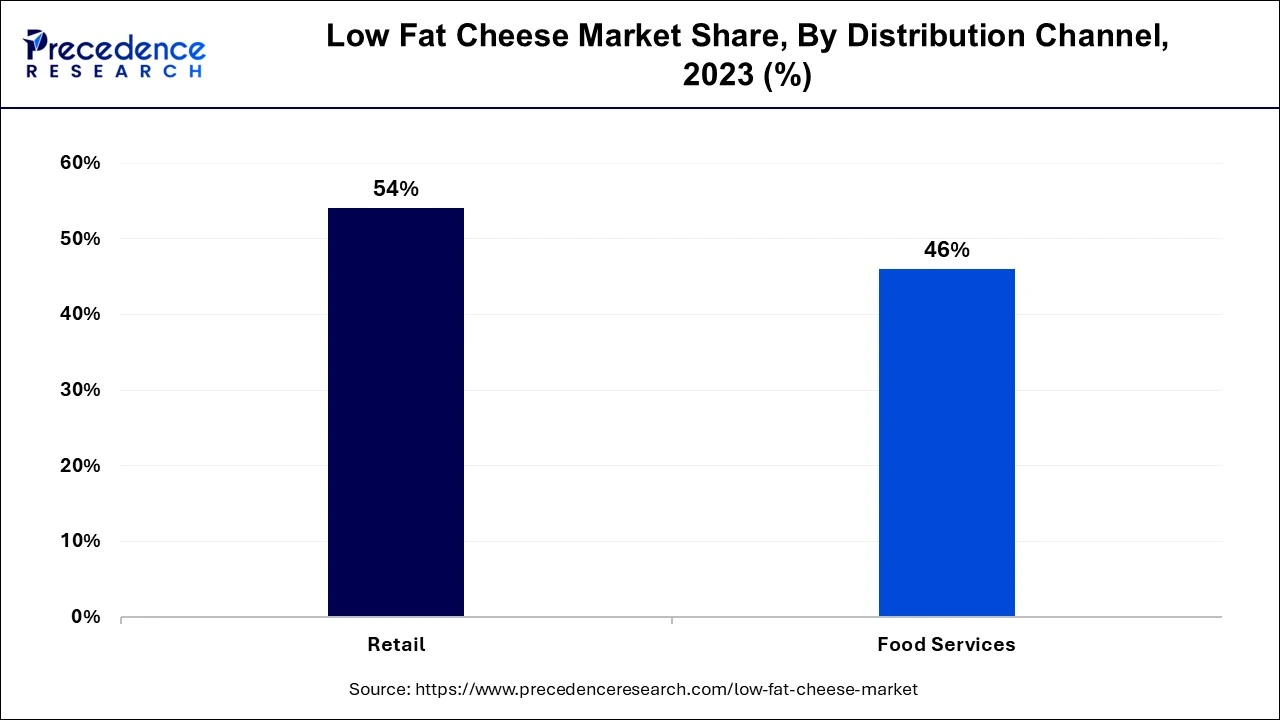
The food services segment is anticipated to grow with the highest CAGR in the low fat cheese market during the studied years, owing to the health-conscious consumers' propensity to order foods containing low-fat cheese. According to the report by the National Restaurant Association, the trend of low-fat and plant-based products is quickly becoming popular in the food services industry. Furthermore, the USDA has also found an upsurge in the emergence of food service outlets that are adding low-fat cheese to pizzas, salads, and sandwiches. This change is in line with the growing trend in demand for places that serve healthy food, further facilitating the demand for low-fat cheese products.
Regional Insights
Europe Low Fat Cheese Market Size and Growth 2025 to 2034
The Europe low fat cheese market size is evaluated at USD 40.27 billion in 2025 and is anticipated to be worth around USD 55.76 billion by 2034, growing at a CAGR of 3.67% from 2025 to 2034.
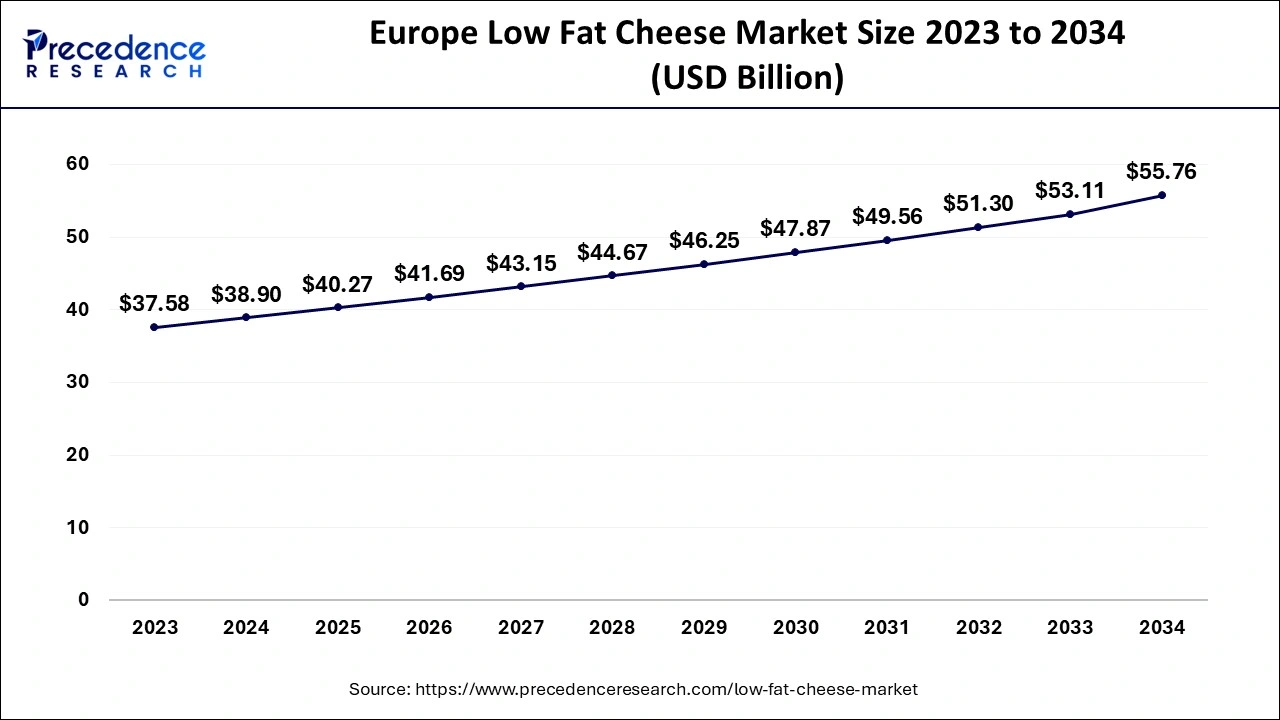
Europe dominated the global low fat cheese market in 2024 due to consumer awareness of trends and issues associated with health and well-being. Therefore, there is great potential in the region because it has been estimated that the it contains almost forty percent of the global market share, as estimated by Euromonitor International.
Another factor that boosted this growth was the FDA's stand on labeling, which banned most claims related to nutrition and labeling and encouraged the use of low-fat products that offer more information on the importance of using low–fat products. Additionally, the increased incidences of lactose intolerance and the need for low-fat diets such as the Keto and Paleo diets further boost the demand for low-fat cheese products in this region.
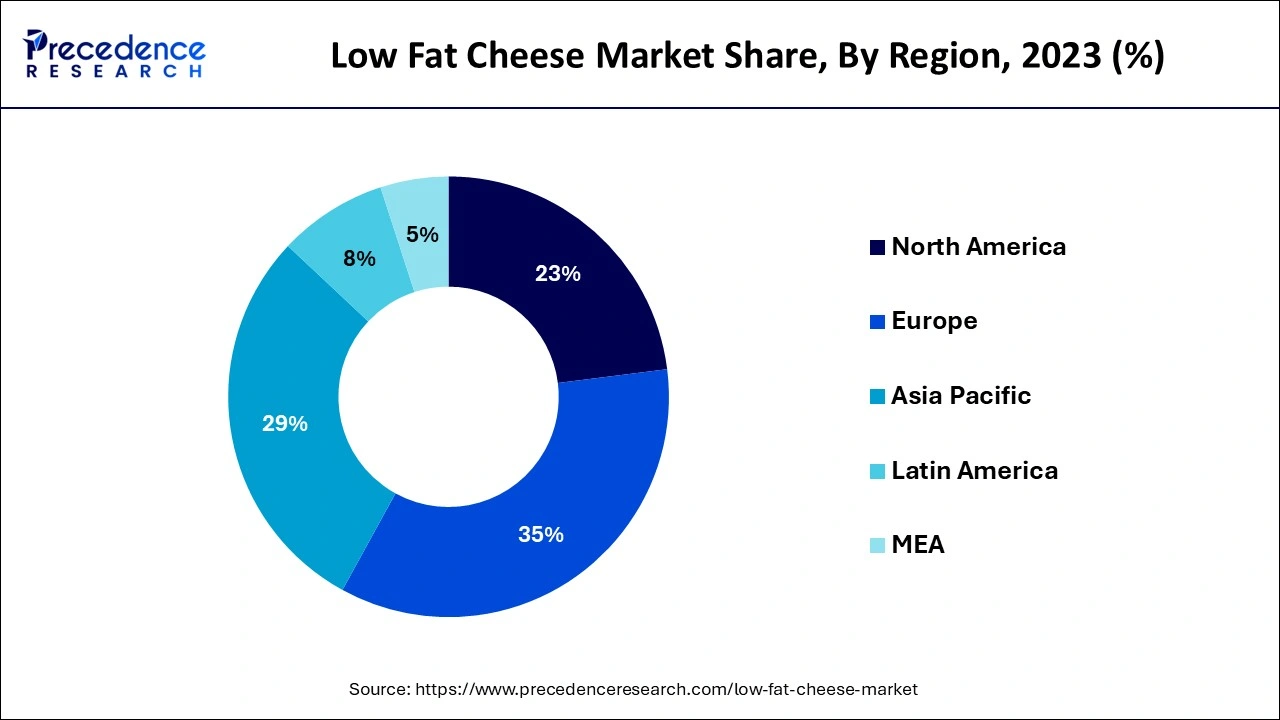
Asia Pacific: China Low Fat Cheese Market Trends
China's market is growing, driven by rising health consciousness, increasing Western style eating habits, and growing popularity of dairy among urban consumers. Demand for lower fat, higher protein cheeses is rising, especially among health- and diet conscious city dwellers, as part of a broader shift toward balanced nutrition. Younger consumers and millennials, often influenced by Western cuisine and social media food trends, are more open to cheese in sandwiches, pizzas, pastas and snacks, which is encouraging producers to expand low fat cheese SKUs.
Asia Pacific is projected to host the fastest-growing low fat cheese market in the coming years, owing to the growing incidence of obesity and other diseases, such as diabetes and high blood pressure. The World Health Organization examines a significant increase in these health conditions in Asia; thus, consumers are shifting towards low-fat dairy products. Furthermore, over the years, due to developments in electronic commerce, including Alibaba and Flipkart, the availability has increased.
Europe: The UK Low Fat Cheese Market Trends
The UK market in 2025 is being shaped by rising health consciousness and changing dietary habits, with more consumers looking to reduce saturated fat while increasing protein intake, boosting demand for reduced-fat and high-protein cheeses such as low-fat cottage cheese. Supermarkets and specialty retailers are expanding their low-fat cheese portfolios, including lower-fat versions of traditional British cheeses, to meet demand from calorie-conscious and flexitarian shoppers.
Why did Latin America grow at a rising rate in the Low-Fat Cheese Market?
Rising urbanization and changing eating habits fueled increased interest in healthier dairy food; therefore, a steady growth in Latin America was expected. More consumers, particularly from major cities, sought low-calorie and reduced-fat options. Retailers had begun to expand their dairy products' shelf space, as well as globally sourced brands entering the region. Local dairy companies have started producing more low-fat products, with supermarket chains enhancing their range of low-fat dairy options.
Brazil Low Fat Cheese Market Trends
Brazil has been leading the way in terms of demand for healthy dairy products, with an increased awareness of weight management among urban consumers. Urban consumers prefer lighter cheese options to incorporate into their daily meals; therefore, local dairy producers have begun to produce a higher volume of low-fat products. As well as this, there has been an increase in the low-fat dairy department within supermarkets, providing consumers with a greater variety of low-fat dairy options.
Why did the Middle East & Africa region grow at a rising rate in the Low-Fat Cheese Market?
Urbanization and the increasing popularity of Western diets have driven an increase in dairy consumption in both the Middle East and Africa. People have begun to look for lighter, healthier cheese options due to the rising number of health issues stemming from poor lifestyles. Regional growth has been stimulated by the opening of supermarkets and convenience stores by international brands.
Saudi Arabia Low Fat Cheese Market Trends
Saudi Arabia has the largest dairy market in the Middle East and North Africa and has also begun to shift towards healthy diets. The increase in demand for low-fat cheese from consumers indicates that consumers prefer this type of cheese for everyday meals, and retailers are providing many global brand options. There are government health campaigns to promote and support the consumption of reduced-fat foods. Along with the increasing popularity of fitness and greater disposable income, Saudi Arabia is maintaining a strong demand for low-fat cheese.
Low Fat Cheese Market Companies
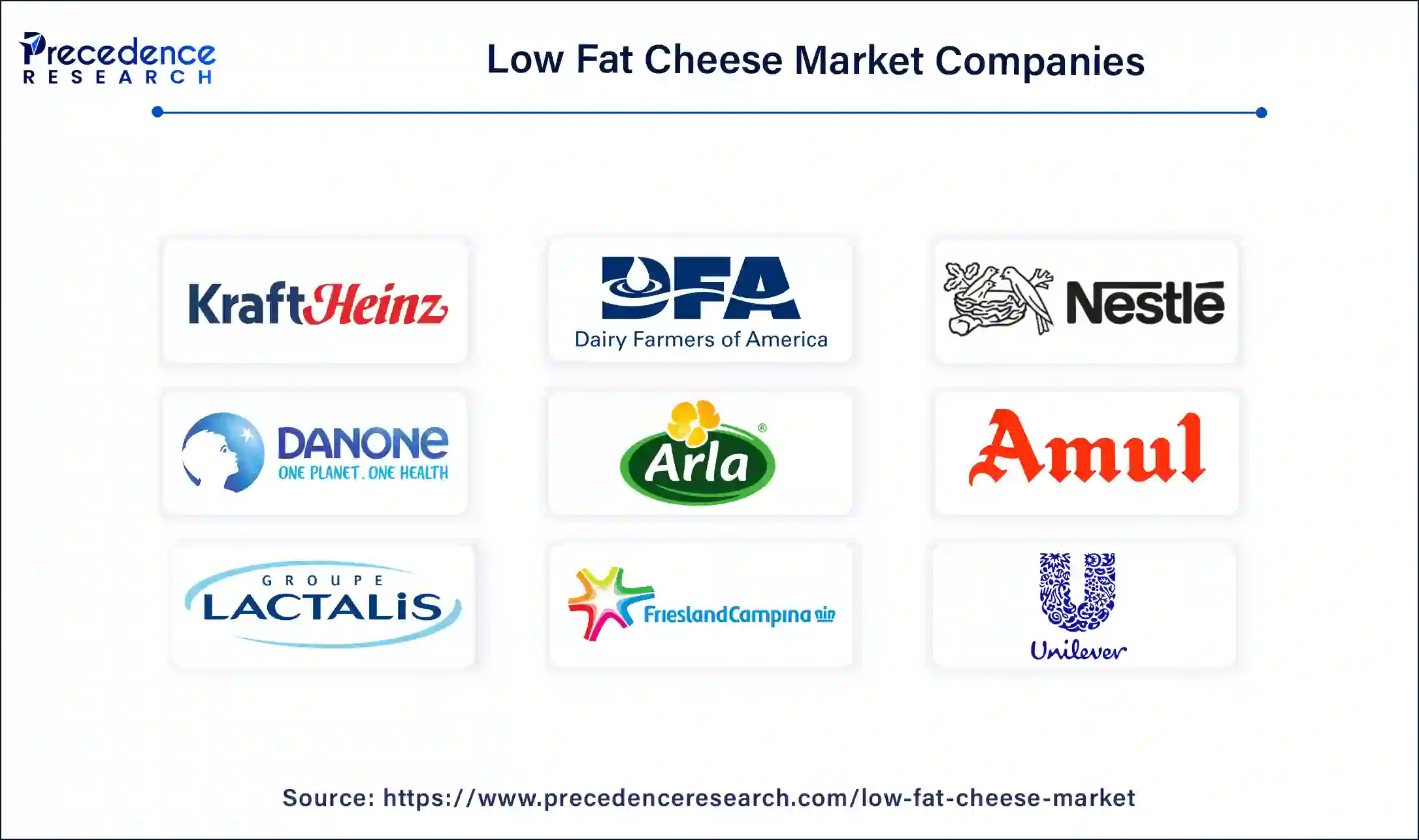
- Kraft Heinz Company
- Dairy Farmers of America
- Nestlé S.A.
- Danone S.A.
- Arla Foods
- Amul Limited
- Arla Foods, Inc.
- Lactalis Group
- FrieslandCampina
- Unilever N.V.
Recent Developments
- In March 2024, Arla Foods launched a new line of low-fat cheese products aimed at health-conscious consumers. This initiative responds to a significant trend reported by the International Dairy Federation, indicating that 68% of consumers prioritize low-fat options in their diets. The new product range features reduced-fat versions of popular cheeses, such as Gouda and Cheddar, developed through extensive research to maintain flavor while cutting fat content.
- In February 2024, Saputo Inc. introduced a new line of low-fat cheese slices tailored for the snack and sandwich market. This product contains 50% less fat than traditional cheese slices, aligning with recent findings from Dairy Farmers of Canada that show a 35% increase in demand for convenient and healthy snacking options. The innovative design of these cheese slices not only caters to health-conscious consumers but also features 100% recyclable packaging, appealing to environmentally aware shoppers. Saputo aims to capture a larger share of the low fat cheese market with this launch
- In April 2024, Horizon Organic expanded its offerings by introducing a new organic low-fat cheese product. This launch addresses the growing demand for organic dairy alternatives, which have seen a 25% sales increase over the past year. The new cheese product emphasizes ethical sourcing and sustainability, resonating with families seeking nutritious options that align with their health goals. Horizon's CEO highlighted the importance of providing organic, low-fat choices to support consumer health initiatives. The product is now available in grocery stores across the nation
Segments Covered in the Report
By Product
- Ricotta
- Feta
- Hard
- Mozzarella Sticks
By Distribution Channel
- Retail
- Food Services
By Region
- North America
- Asia Pacific
- Europe
- Latin America
- Middle East and Africa
For inquiries regarding discounts, bulk purchases, or customization requests, please contact us at sales@precedenceresearch.com
Frequently Asked Questions
Ask For Sample
No cookie-cutter, only authentic analysis – take the 1st step to become a Precedence Research client



